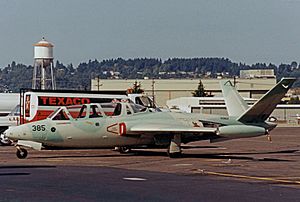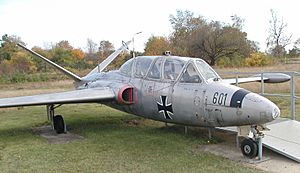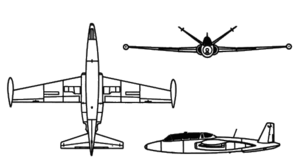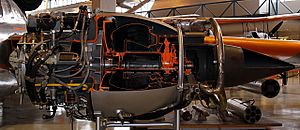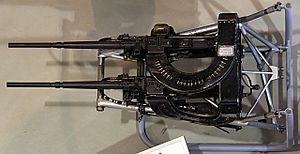Fouga CM.170 Magister facts for kids
Quick facts for kids CM.170 Magister |
|
|---|---|
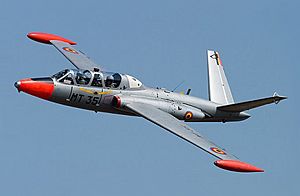 |
|
| A Magister of the Belgian Air Force | |
| Role | Jet trainer |
| National origin | France |
| Manufacturer | Fouga, merged with Potez, merged with |
| First flight | 23 July 1952 |
| Introduction | 1956 |
| Status | Retired; continues as civilian-owned warbirds |
| Primary users | French Air Force Israeli Air Force German Air Force Finnish Air Force |
| Number built | 929 total Air Fouga: 576 Heinkel-Messerschmitt: 194 IAI: 36 Valmet: 62 |
| Variants | Fouga CM.175 Zéphyr |
The Fouga CM.170 Magister is a French two-seat jet trainer aircraft from the 1950s. It was designed and built by the French company Fouga. You can easily spot it by its unique V-tail, which looks like a butterfly's tail.
Nearly 1,000 Magisters were built. Many were made in France, and others were built under license in West Germany, Israel, and Finland.
The idea for this jet trainer started in 1948. The French Air Force wanted a new plane to train pilots using jet engines. The first design was made bigger and given two powerful Turbomeca Marboré turbojet engines.
The first Magister flew on July 23, 1952. It was used mainly for training pilots. However, it was also used in battles to support ground troops by several countries. It saw action in conflicts like the Six-Day War and the Salvadoran Civil War.
The Magister was also a favorite for many aerobatics display teams, including the famous Patrouille de France. In France, the Magister was later replaced by the Dassault/Dornier Alpha Jet. After retiring from military service, many Magisters were bought by private pilots.
Contents
How the Magister Was Developed
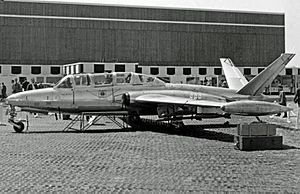
In 1948, designers at the French company Fouga started working on a new jet-powered training aircraft. It was meant to replace older propeller planes used by the French Air Force.
The Air Force looked at the first design but felt it wasn't powerful enough. So, Fouga made the plane larger and gave it stronger Turbomeca Marboré engines. They kept the special butterfly tail design, which was already used on Fouga's gliders for jet engine tests.
In December 1950, the French Air Force ordered three test planes. The very first one flew on July 23, 1952. Soon after, more planes were ordered for production.
Parts for the Magister were made by different companies. Final assembly happened at a new Fouga factory in Toulouse-Blagnac. If other countries wanted to buy the Magister, their orders were often given priority. This meant they could get their planes quickly.
The French Navy also wanted a version of the Magister that could land on aircraft carriers. This special version was called the Fouga CM.175 Zéphyr.
By 1960, over 350 Magisters were in service. France was building about five planes each month. The Magister was also built in other countries under special agreements. These included West Germany, Finland, and Israel. In total, 286 Magisters were built in these countries.
An improved version, the CM.170-2 Magister, came out in 1960. It had more powerful engines. Production of the Magister in France stopped in 1962. However, it continued to be built in Finland until 1967.
Magister Design and Features
The Fouga CM.170 Magister was designed for both basic and intermediate pilot training. It's a small plane with two seats, one behind the other. It performs like bigger, more powerful aircraft.
A key feature is its unique butterfly tail. This design worked better at higher speeds than a normal tail. A special fin under the back of the plane helps keep it stable.
The Magister has two Turbomeca Marboré turbojet engines. Each engine provides 880 pounds of push. Having two engines makes it safer for training. If one engine stops, the other can still fly the plane. The engines are placed close together, so if one fails, the plane doesn't pull too much to one side.
The plane was designed to be easy to fly and maintain. Its engines could be replaced in about 45 minutes.
The Magister could also carry weapons. It could have two 7.5 mm guns in its nose. It also had strong points under its wings to carry up to four rockets or two 110-pound bombs. This allowed it to be used for combat missions.
The cockpit was designed for pilot comfort and safety. It had a fresh air system and was pressurized, meaning the air inside was kept at a comfortable pressure even at high altitudes. The controls were easy to see and use. The front pilot had excellent views. The instructor in the back seat had a special periscope to see over the front pilot.
Pilots found the Magister easy to fly and control. It was very stable in the air, meaning it could fly straight without much effort from the pilot.
Magister in Action Around the World
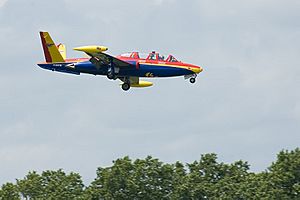
Israel
The first Fouga Magister arrived in Israel in 1957. Soon after, Israel started building its own Magisters under license, calling them the IAI Tzukit. The first Tzukit was ready in 1959 and began service in 1960.
These planes were used at the Israeli Air Force's flight school for jet training. They also formed the IAF Aerobatic Team. In 1974, the Magisters were replaced for advanced training but continued for basic training. In the 1980s, many Tzukits were updated with new engines and cockpits.
In 1964, the flight school formed a special squadron of Magisters. During the 1967 Six-Day War, 44 Fougas from 147 Squadron were used for close air support. They attacked targets in the Sinai Peninsula and later against Jordanian forces. The Magisters were very effective, destroying many tanks and vehicles. However, they also suffered heavy losses, with seven planes and six pilots lost.
El Salvador
El Salvador bought nine former Israeli and three French Magisters. They used them as trainers and for ground attacks during the Salvadoran Civil War. They carried bombs and machine guns. These planes worked with other aircraft like the Ouragans and A-37Bs. None were lost to enemy fire, but only five were still flying by the end of the war.
Finland
Finland bought 18 Magisters from France in 1958–1959. They also got permission to build them. The Finnish company Valmet built 62 more Magisters between 1958 and 1967. Finland planned to use them for attacks if there was a war, as they had a limited number of attack planes.
The Magisters served as jet trainers in the Finnish Air Force from 1958 to 1988. They were later replaced by BAe Hawks. Sadly, 21 Magisters were lost in accidents, with six of them being fatal. Finnish pilots often called the plane Kukkopilli, which means "Ocarina," because of the unique sound of its engines.
Belgium
The Belgian Air Force used 50 Magisters for primary training. Their aerobatic team, The Red Devils, also used them for air shows. A few Magisters were used until September 2007 for flight maintenance. Belgium was the last country to use Magisters for active military duty.
Brazil
The Brazilian Air Force (FAB) used the Magister in their aerobatic display team, the Esquadrilha da Fumaça. They flew them from 1968 to 1975. These planes were called T-24 in Brazil.
Morocco
The Moroccan Air Force bought 25 Magisters from France between 1956 and 1970. They used some of them in the Western Sahara War. Several were lost in action, leading to the Magister being replaced by Alpha Jets for combat duties in the 1980s.
Ireland
The Irish Air Corps flew six Magisters from 1975 to 1999. They bought them to replace older De Havilland Vampire planes. Four of the Magisters were bought secondhand from Austria. The other two were originally meant for another country but were taken during a conflict. All six planes were made like new before the Irish Air Corps used them. They were mainly used for light attacks and advanced training. Four of the Magisters were part of the Air Corps display team, the Silver Swallows.
Cambodia
Cambodia's Royal Cambodian Air Force used four Magisters starting in 1961. At first, they were only for training. Later, they were also used as light attack aircraft. Cambodian Magisters were very active in the Khmer Air Force from 1970. They formed a Light Attack Squadron with other planes and were often used for combat missions.
Magister Versions
- CM.170 Magister: The first test planes and early production models.
- CM.170M Magister: Two test planes for the French Navy.
- CM.170R: The first main production version of the Magister.
- CM.170-1 Magister: The first production version with Turbomeca Marboré II engines. Many were built in France, West Germany, Finland, and Israel.
- CM.170-2 Magister: An improved version with more powerful Turbomeca Marboré VI engines.
- CM.171 Makalu: A larger version with different engines. Only one was built before it was lost in an accident.
- CM.173 Super Magister: A version with even stronger engines and ejection seats. Only one was built.
- Fouga CM.175 Zéphyr: A special version for the French Navy. It had a stronger landing gear, hooks for carrier landings, and catapult attachments.
- Potez CM.191: A proposed 4-seat version of the Magister. Two were built.
- IAI Tzukit: This is the Israeli Air Force version. It was updated with a new cockpit and modern materials.
- Fouga 90/90A: A newer design based on the CM.170. It had different engines and a redesigned cockpit for better visibility. These versions did not get any orders.
Who Used the Magister?
 Algeria Algerian Air Force
Algeria Algerian Air Force Austria Austrian Air Force
Austria Austrian Air Force Bangladesh Bangladeshi Air Force
Bangladesh Bangladeshi Air Force Belgium Belgian Air Component
Belgium Belgian Air Component Brazil Brazilian Air Force
Brazil Brazilian Air Force Cambodia Royal Khmer Aviation
Cambodia Royal Khmer Aviation Cameroon Cameroon Air Force
Cameroon Cameroon Air Force El Salvador Air Force of El Salvador
El Salvador Air Force of El Salvador Finland Finnish Air Force
Finland Finnish Air Force France French Air Force
France French Air Force France French Navy
France French Navy Gabon Presidential Guard
Gabon Presidential Guard Germany German Air Force
Germany German Air Force Guatemala Guatemalan Air Force
Guatemala Guatemalan Air Force Ireland Irish Air Corps
Ireland Irish Air Corps Israel Israeli Air Force
Israel Israeli Air Force Katanga Katangese Air Force
Katanga Katangese Air Force Lebanon Lebanese Air Force
Lebanon Lebanese Air Force Libya Libyan Arab Air Force
Libya Libyan Arab Air Force Morocco Royal Moroccan Air Force
Morocco Royal Moroccan Air Force Senegal Senegalese Air Force
Senegal Senegalese Air Force Uganda Ugandan Air Force
Uganda Ugandan Air Force
Magister Specifications (CM.170-1)
Data from Jane's All The World's Aircraft 1965–66
General characteristics
- Crew: 2
- Length: 10.06 m (33 ft 0 in)
- Wingspan: 12.15 m (39 ft 10 in) (over tip tanks)
- Height: 2.80 m (9 ft 2 in)
- Wing area: 17.30 m2 (186.2 sq ft)
- Aspect ratio: 7.42:1
- Airfoil: NACA 64 Series
- Empty weight: 2,150 kg (4,740 lb)
- Gross weight: 2,850 kg (6,283 lb) (without tip tanks)
- Max takeoff weight: 3,200 kg (7,055 lb)
- Fuel capacity: 730 L (190 US gal; 160 imp gal) internal fuel; 980 L (260 US gal; 220 imp gal) with tip tanks
- Powerplant: 2 × Turbomeca Marboré IIA turbojets, 3.9 kN (880 lbf) thrust each
Performance
- Maximum speed: 715 km/h (444 mph; 386 kn) at 30,000 ft (9,100 m)
- Never exceed speed: 860 km/h (534 mph; 464 kn) (Mach 0.82)
- Range: 1,200 km (746 mi; 648 nmi) (with external tanks)
- Endurance: 2 hr 40 min (with external tanks)
- Service ceiling: 11,000 m (36,000 ft)
- Rate of climb: 16.99 m/s (3,345 ft/min) (without tip tanks)
- Takeoff distance to 15 m (50 ft): 930 m (3,050 ft)
Armament
- 2× 7.5 mm or 7.62 mm machine guns, 200 rounds/gun
- Up to 140 kg (310 lb) of weapons on two underwing hardpoints, including 50 kg (110 lb) bombs, unguided rockets (T 10, T 900 or SNEB rockets pod), and Nord Aviation SS.11 anti-tank missiles.
See also
 In Spanish: Fouga Magister para niños
In Spanish: Fouga Magister para niños
- List of military aircraft of France
- Aircraft related to this one
- Fouga CM.175 Zéphyr
- Similar aircraft
- Aero L-29 Delfín
- BAC Jet Provost
- Cessna T-37 Tweet
- Fiat G.80
- Fokker S.14 Machtrainer
- Fuji T-1


